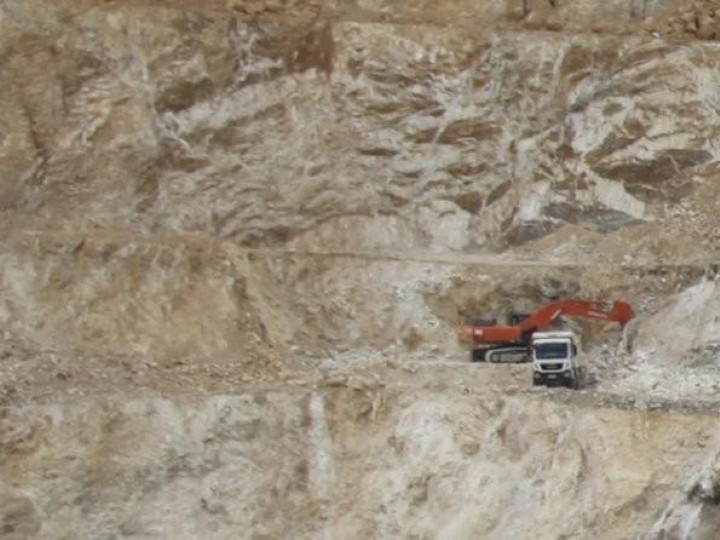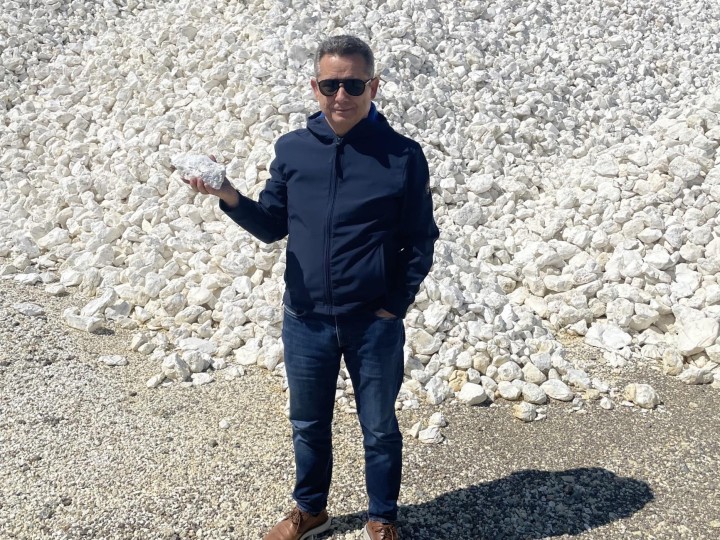Turkey has the worlds highest quality Magnesite deposits.Gel type magnesite produce ( caustic calcined and Dead burned magnesite)our Country .For many years both in Raw ore and semi-finished goods have remained in the wide demand of countries.Big uncertainty in magnesite mining mineralization ,type and quality changes and risk,business machine ,size of capital allocated for construction machinery ,one of the most importante items of investment ,high fuel prices in the country ,legislation on the use of explosives required for production ,high explosive material prices .High road transport prices.Magnesite mine is used both as raw and colcined and dead burned ,after a large part of the magnesite mine in our country has been Dead Burned Magnesite and used as raw material of refractory industry
Magnesite Mineral Hardness: 3.4-4.5
Magnesite المغنسيت)(specific gravity :2.9-3.1
Tecnodieci Caustic Calcined Magnesia(CCM)is reactive form of MgO produced by firing magnesita at temperetures betwen 800-1000 C ,Tecnodieci Calcined Magnesite produces and commercializes a great varietyof caustic calcined magnesia products for the widest spectrum of applicationsnamely agricultural ,industrial/technical chemical ,construction ,environmental,steel,refractories.Our productsare acknowledged as top quality
Tecnodieci Caustic Calcined Magnesite( % on ignited basis )83-87-90-97
CCM can bu usedin;
Agricultural applications
Animal Nutrition
Fertilizers
Rubber and Plastic
Mineral insulated
Refractory Raw Material
Glass İndustry
Magnesium chloride
Pulp and paper
Sorel cement
Environmental applications
Glass industry
Our country has the world's best quality natural magnesite deposits. Gel type magnesites produced in our country have remained in the wide demand area of various countries for many years, both as raw ore and as semi-finished products (calcined and sintered magnesite).
Magnesite is a mineral that can be used either raw, calcined or sintered. However, most of the magnesite minerals produced in our country are used in the production of sintered magnesite, which is the raw material of the refractory industry, after being sintered at 1650-2000 °C. Before the magnesite mineral was discovered, J.E.Delanetherie named its salts such as Magnesium Carbonate, Sulphate, Nitrate and Chlorite as "Magnesite" in 1795. A.Brongmart used the same term for magnesium carbonate and silicates, in 1803 “C.F.Ludwing described natural magnesium in Moravia” and in 1808 “D.L.G. Karsten named magnesium carbonate "magnesite".
The first information about the use of magnesite as a refractor in metallurgical processes dates back to 1866-1868. In 1890, magnesite began to be used as a lining in besemel and open furnaces in Europe. In 1913, magnesia (MgO) was produced from dolomite in Pennsylvania (USA), and in 1885, synthetic magnesite was obtained by precipitating magnesium hydroxide from seawater in France. M.T.A. According to the General Directorate reports, magnesite exploration in Turkey was first carried out in Sakarya in 1808 by the "France Elektore Coulant" company. The first magnesite production started in 1929 and continued to increase until 1962, and has increased rapidly since 1962. Calcined magnesite production started in 1940 and did not show a significant increase until 1964, and it has been observed that production has increased since then. In the 1960s, a facility was established by the French and Austrians in Sepetçi village and Margı (Kozlubel) village in the central district of Eskişehir to produce calcined magnesite, but these facilities are not working now.
Magnesite; Its formula is MgCO3, and it is a mineral with a theoretical composition of 52.3% CO2, 47.7% MgO and a very small amount of Fe2O3, with a hardness between 3.4-4.5 and a specific gravity of 2.9-3.1. Its color varies between white, yellow or gray and brown. It occurs in two forms in nature: Cryptocrystalline (gel/amorphous) and Crystalline (coarse crystalline). It is a hard and complex mineral and is formed as a result of the alteration of serpentine or similar rocks or contact metamorphism of dolomites. There are also magnesite deposits with sedimentary formation. Cryptocrystalline magnesite is generally found pure, although some iron, lime, alumina and a small amount of free silica may be mixed. The quality of the ore also increases or decreases depending on the amount of compounds it contains. Clayey levels accompany magnesite in the zone, which reaches a thickness of approximately 30 m in Erzincan. As with calcite and dolomite, magnesite loses (decomposes) its CO2 content when heated. Caustic calcined magnesite is produced by heating between 700 and 1000°C. It is very dense and hard, containing max. 0.5% CO2, by heat treatment between 1650-2000°C; Sintered magnesite is subjected to heat treatment above 2500°C in Electric Arc Furnaces to obtain fused magnesium oxide (fused magnesite), which is a dense substance similar to flint. The specific gravity of fused magnesite is 3.65 and it can withstand very high temperatures.
Magnesium is an important raw material of today's technology, both as a metal and as a compound. The largest magnesium consumption occurs in the form of magnesium compounds (MgO, MgCl2, Mg(OH)2, MgSO4, etc.). Chief among all these is MgO (Sintered Magnesite), which covers 80% of the total world consumption and is called magnesia. Because MgO is the most important input of the refractory material industry due to its high melting point. The most important source of this magnesia and even other magnesia compounds is magnesite. Magnesite is a magnesium carbonate mineral and one of the common compounds in nature. It is very difficult to find magnesite in nature with properties suitable for the requirements of its usage areas. Because the presence of any foreign element in magnesite, more or less than 0.1%, can determine whether magnesite can be evaluated economically with today's technology. However, our country is very lucky in that it has the best quality magnesite in the world. Low porosity, high refractoriness, high strength, volume stability and chemical resistance are sought in magnesite. The specific gravity must be greater than 3.0 g/cm3 and the Boron content must be maximum 0.17%.
Quality amorphous magnesites are found in Greece, Yugoslavia and Brazil, apart from Turkey. The formation of magnesite ore and its formation conditions have not been revealed precisely, despite all studies (Rosemberg and Milles, 1966; Johannes, 1966, 1967, 1969; Christ and Hostetler, 1973; Sayles and Fyte, 1943). In the research conducted so far, magnesite formation depends on the pH and EH values in the environment,
Magnesium Oxide; It is used in the ceramic sector, except for some special glazes, together with calcium oxide. Like calcium ion, it has high flux at high temperatures. It reduces viscosity. The most effective temperature range is 1200 C. It has an increasing effect on the formation of the layer between the glaze and the body. It affects the development of cobalt purple and nickel green colors in the glaze. When magnesium-containing glazes are fired in a reducing environment, a gray color formation is observed.


